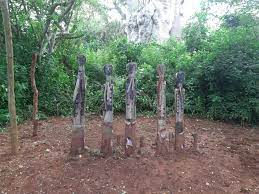Create Your First Project
Start adding your projects to your portfolio. Click on "Manage Projects" to get started
Kigango/ Vigango/ Memorial Posts
The Giriama and Chonyi people of the Kenyan coast are known for their long-standing tradition of carved wooden mortuary posts. These Vigango (s. kigango) commemorate ancestors and honor their legacy. Vigango are vertical wood planks incised with symbolic patterns and painted in bright colors. The vertical posts are embedded into the earth, creating a connection between the living and the dead. The posts vary in size ranging from 4 to 8 feet in height, visualizing the connection between the ancestral realm and the earth. The posts are carved for various reasons, honoring ancestral spirits, mediators between the world of the living and departed, and to harness the power of Koma (ancestral power) to prevent destructive forces.
The planks are cut from living trees by selected men of the Gohu (male fraternal society) who are responsible for its construction. They are then carved with intricate geometric patterns and painted with red, black, blue, or white pigment that results in a dynamic contrast of color and form. The decoration on the front of the Kigango on the left contains diaper work (geometric patterning), believed to be inspired by Islamic influence. Simplistic features were carved into the face of the sculpture, enhancing its humanistic elements. The colors typically used are white (Kama) and blue (Bulvu) inlay with red ochre (Mbvu) on the body of the post. The blue is said to represent the sky or a spirit. Before the blue and white became more readily available charcoal substituted the blue pigment and the white inlay was made of ground down snail shells as opposed to a 'chalk', both were bound together using a latex extract from a tree or cactus leaves (Muvila). According to the spiritual leaders these posts have only one life, reflecting our own. Due to the nature of the materials, many of the Vigango decay or a village may move, leaving the Vigango behind. If this occurs, they are often replaced by a Kibao (Vibao - plural), which is placed in line in a shrine or shelter in the homestead. The posts maintain a strong connection to the spirit of the ancestors and are an ongoing visual reminder to respect the legacy of elders and to acknowledge the important roles they play in maintaining social standards.
Sources:
Blackmun-Visona, Monica, et. al. A History of Art in Africa. 2nd ed. Upper Saddle River, N.J.: Pearson: Prentice Hall, 2008, pp. 438.
Memorial Post. The Collection Online, Metropolitan Museum of Art, New York

















